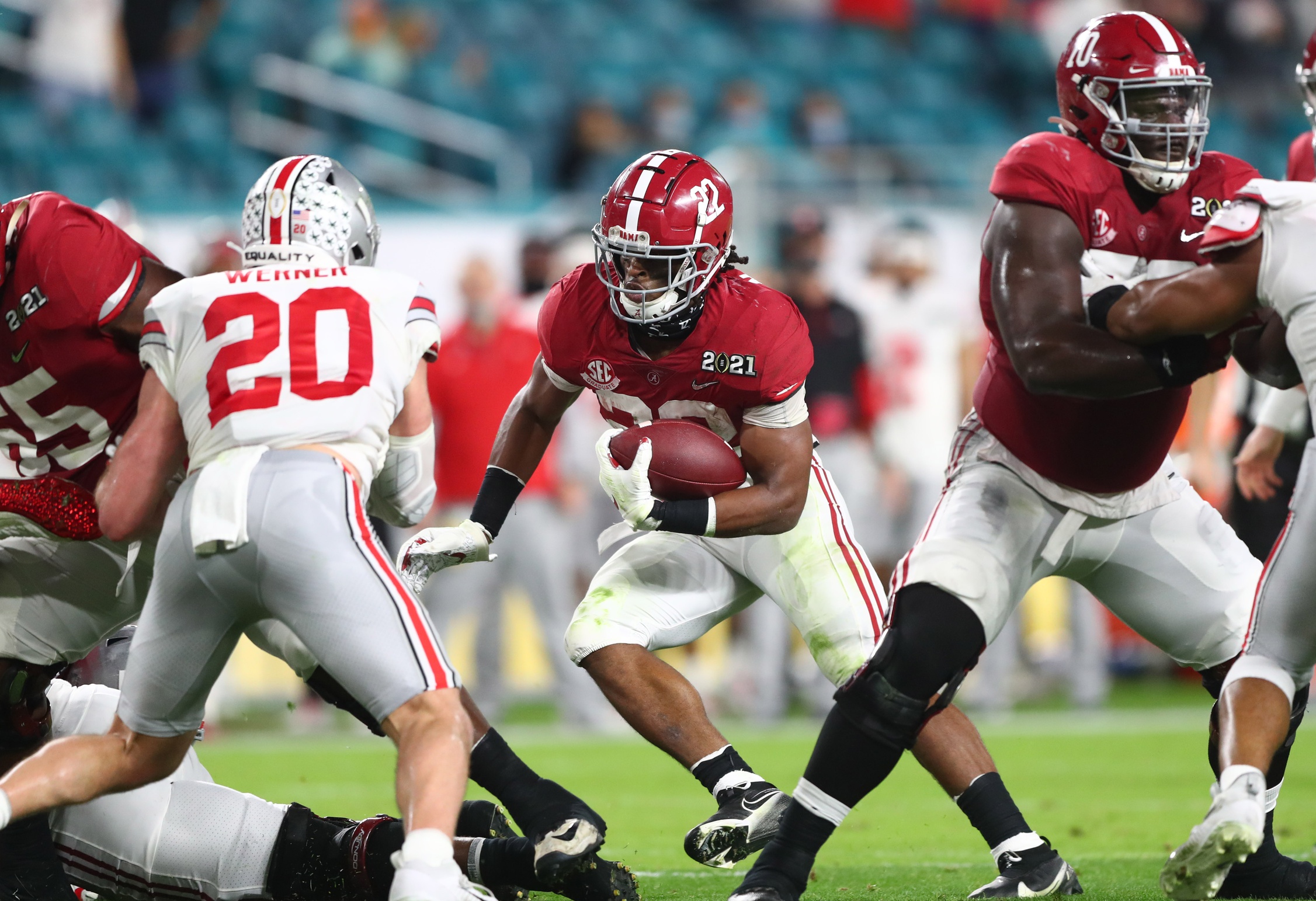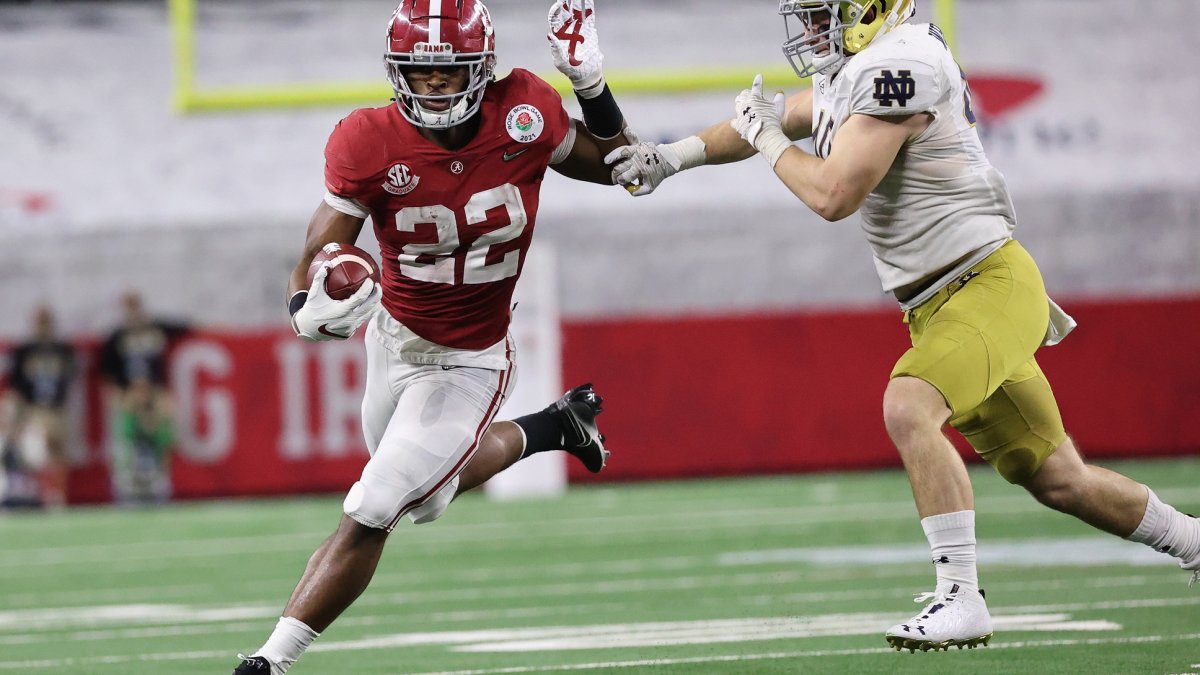Finding fantasy football bell cow running backs in line for 20-plus touches is rare in today’s pass-happy NFL. Only six RBs averaged more than 20 touches per game in 2020, and only four totaled more than 300 touches. In 2012, we saw 10 running backs exceed the 300-touch threshold.
Subscribe to
Of those 10 RBs, nine finished as top-12 fantasy options at the position. Rookies Doug Martin, Alfred Morris and Trent Richardson were part of that group, all finishing top-eight at the position. Richardson averaged a measly 3.6 yards per attempt but was still one of the top fantasy backs.
Needless to say, the sheer volume these running backs saw played an integral role in their successful fantasy seasons — a reminder that a heavy workload trumps efficiency.
Which brings us to the highly debated topic of incoming rookie running back Najee Harris‘ potential to succeed behind the Pittsburgh Steelers’ porous offensive line. Maybe I've already given away the answer, but let's examine the numbers that suggest Harris’ projected volume will allow him to rise above the offensive line problems and lock him into top-15 fantasy RB production in 2021.
VOLUME VS. OFFENSIVE LINE EFFICIENCY
To examine what matters more when it comes to predicting RB fantasy points, I conducted a simple correlation analysis. I tallied fantasy points scored by running backs (since 2012) and identified the correlation between the total and two variables featured: touches and PFF run-blocking grade.
Touches represent running back volume, and PFF run-blocking grade represent the efficiency offense line play. The grading isn’t always an exact science, but I doubt anybody will argue that the Steelers didn't earn the league's 31st-ranked grade last season.
The findings confirmed my priors — running back volume is by far the superior predictor of fantasy points compared to OL play. The positive correlation coefficient produced between RB touches and fantasy points was extremely strong (0.72). The positive correlation coefficient produced between RB touches and PFF run-blocking grade was not (0.26).
This shouldn’t come as Earth-shattering news — volume has always been and will be the king in fantasy football — but concrete evidence behind the concept helps us understand it better.
We also saw prime examples last season of running backs overcoming poor offensive lines when given the lion’s share of touches. James Conner — who had the “luxury” of running behind the Steelers’ horrendous offensive line — had at least 12 touches in 10 games.
In those games, Conner averaged 16.5 touches, 15.5 fantasy points and 16.1 expected fantasy points. His fantasy/expected points would have ranked 15th- and 12th-best in the league among all RBs.
Basically, when Conner saw a heavy workload, he was a top-15 fantasy running back.
When ho-hum backup Benny Snell managed the bulk of touches in relief of Conner for a three-game stretch, he averaged 15 touches, 14.4 fantasy points and 17.0 expected fantasy points per game. That’s more than serviceable coming from a former Day 3 selection.
Other productive running backs also overcame bad OL play last season. As noted, Pittsburgh ranked 31st in PFF run-blocking grade — the Los Angeles Chargers were the only team that graded worse.

Austin Ekeler played nine healthy games in 2020. In those contests, Ekeler averaged 18.5 touches, 18.1 fantasy points and 18.4 expected fantasy points per game. His fantasy/expected points would have ranked sixth- and fifth-best in the league among all RBs.
When Ekeler was hurt, Kalen Ballage — famous for his 1.8 yards per carry average in 2019 — operated as the team’s workhorse for a three-game stretch. The “plodder” averaged 21 touches and 15.2 fantasy points per game. After being the punchline of jokes after an atrocious 2019 campaign, Ballage was a top-15 fantasy running back for a stretch almost entirely due to volume alone.
Colossal opportunities turn replacement-level backs into fantasy producers regardless of offensive line contributions. This is true even when a running back ranks poorly in fantasy points scored under expectation (Snell: -35.6; Ballage: -29.3). Part of this inefficiency can be attributed to the offensive line play, but it also reflects their overall talent. Still, volume allowed these backup players to overcome both factors.
Conner (-11.9) and Ekeler (-2.3) are starting-caliber and more talented running backs, which is why their fantasy points under expectation weren't nearly as severe rushing behind poor OLs.
The bottom line: Bad line play can lower a running back’s ceiling, but it doesn't stop a talented back from being an above-average fantasy producer, especially when he is involved in the passing game.
RECEIVING WORK
For the majority of the backs I’ve mentioned, reception totals on top of their carries helped make up for losses in efficiency running the football.
Najee Harris is an excellent pass-catcher — a massive chunk of his senior-year production stemmed from receiving work. His 43 receptions on 53 targets were career highs and ranked third in the nation. He dropped only one target and forced a league-high 22 missed tackles after the catch.
The immobile, 39-year-old Ben Roethlisberger won’t be taking off scrambling anytime soon, so I fully expect Harris to be involved throughout the season catching balls out of the backfield.
Steelers just got a guy in Najee Harris who likes to jump over human beings on the football field pic.twitter.com/v4q9DcVjde
— CBS Sports (@CBSSports) April 30, 2021
I also found a small negative correlation between run-block grade and receptions for running backs. Conceptually, this makes sense because quarterbacks often get rid of the ball faster when playing behind poor offensive lines, targeting receivers running routes closer to the line of scrimmage.
2021 PROJECTED WORKLOAD
So how much work will Harris see in the Steelers’ backfield?
PFF’s Jarad Evans pulled a great stat on Twitter: Ex-Steelers bell cow Le’Veon Bell averaged 24.9 touches per game with the team from 2013-2017.
Le’Veon Bell averaged 24.9 touches per game on the Steelers from 2013-2017
Najee Harris is going to eat ???? pic.twitter.com/aU1vrOPE2b
— Jarad Evans (@PFF_Jarad) May 5, 2021
Mike Tomlin and new OC Matt Canada could replicate Bell’s high-end workload with their 2021 first-round pick, who is a similar size and weight. I’ll admit that 25 touches per game are in the upper percentile range of outcomes (425 touches in a 17-game season is a lot of touches these days), but 16-20 touches seems like a safe floor projection based on the team’s RB usage last season and Tomlin’s historical approach of relying solely on one back.
Two-hundred-fifty touches are his absolute floor, assuming health. I won’t be surprised in the slightest to see him hit 300 touches.
SLIGHT OFFENSIVE LINE UPGRADES
I don’t anticipate the Pittsburgh Steelers employing an elite offensive line anytime soon, but they should be slightly better in 2021 after some offseason moves. The team selected two linemen in the draft: third-round center Kendrick Green from Illinois and tackle Dan Moore Jr. from Texas A&M in the fourth round.
Green is projected to fill in as the team’s starting center after Maurkice Pouncey retired. Pouncey was PFF’s fifth-lowest-graded run-blocker at the center position in 2020. Green was PFF’s third-highest-graded interior run-blocker last year among FBS draft-eligible players and earned an impressive 92.3 run-blocking grade on outside zone concepts.
Najee Harris owns PFF’s fourth-highest grade (87.7) when running outside zone since 2019.
Moore doesn’t project to start, but he does add depth and experience blocking in the outside zone scheme.
Pittsburgh also selected tight end Pat Freiermuth in the second round. On the surface, a tight end influencing the run game to any extent seems like a stretch, but the OL got zero help from its tight ends blocking last season. Among 50 qualifying tight ends, Vance McDonald and Eric Ebron ranked outside the top 40 in PFF run-blocking grade in 2020.
As a more natural in-line blocker, Freiermuth could provide juice in the run game when Pittsburgh deploys 12 personnel.
And let’s not forget that the Steelers will be returning tackle Zach Banner, who tore his ACL in Week 1. Banner was a top-10-graded run-blocker in 2019.



 © 2025 PFF - all rights reserved.
© 2025 PFF - all rights reserved.